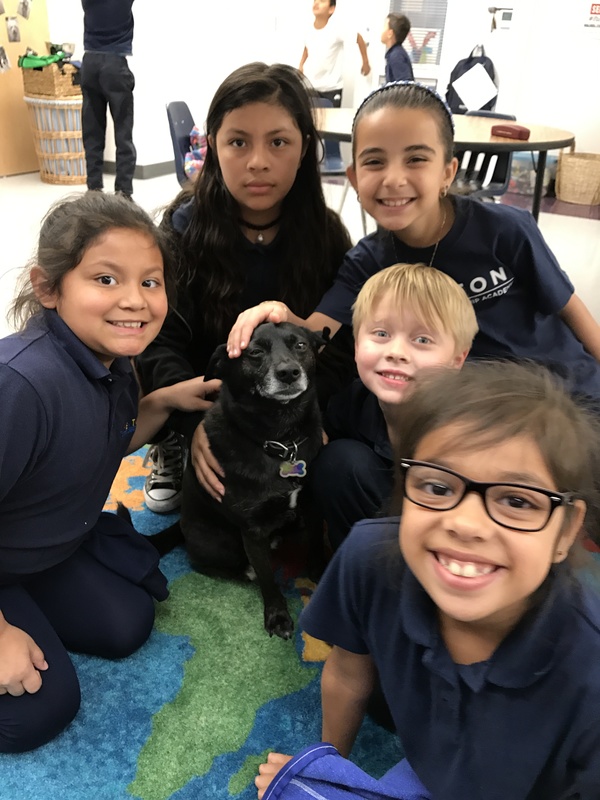The Mutt-i-grees Curriculum was developed as a collaboration between a world-renowned animal welfare organization, North Shore Animal League America, and Yale University School of the 21st Century, part of the Yale Child Study Center. Mutt-i-grees strives to create a humane world and provide opportunities for children to grow up learning to be confident and caring – about themselves, other people, and animals.
Inspired by the research on the benefits of human-animal interactions, in particular, dogs’ ability to help people become calm and socially connected, the Mutt-i-grees Curriculum was developed to teach children Social and Emotional Learning (SEL) skills using canine-assisted activities and interactions. The program is a unique combination of social emotional learning, humane education, and service learning.
Developing resilience is an important part of human growth for both personal and academic achievement. Children face daily challenges and need to be equipped with effective skills and resources if they are to deal with the stress of school life and beyond. To be socially and emotionally competent, children need self-awareness and an understanding of the world around them. The Mutt-i-grees Curriculum leverages children’s interest in pets as well as the benefits associated with pets, especially dogs, to promote resiliency and emotional competence, improve behavior and social interactions while enhancing their awareness of homeless animals – shelter animals.
The opportunity to interact with pets, or simply routinely think about pets, can provide social support and increased health and wellbeing. The research also suggests that pets can increase the sense of community and sociability. Pets provide opportunities for important social and emotional growth. Not every child has access to a companion animal. The Mutt-i-grees Program brings the opportunity for schools to connect with their local shelter for children to have the experience.
The Mutt-i-grees curriculum builds on children's natural love of pets and provides a real-life context within which to teach critical skills. Children are supported to be caring and confident people who can make a difference to their school and wider community. It gives them a platform to take leadership and no longer be a child with challenges, but a trusted, caretaker.
The curriculum is built on a series of lessons designed to help children identify their strengths, skills and talents and areas in which they can grow. The lessons are presented in five units: Achieving Awareness, Finding Feelings, Encouraging Empathy, Cultivating Cooperation, and Dealing with Decisions. Activities and reading mostly focus on dogs. Schools are encouraged to establish partnerships with their local animal shelter, or adopt a school dog to give the children firsthand experience of subject matter while providing experiential lessons.
Integrated throughout the curriculum are feature lessons on the principles of dog behavior. These features were developed to teach children about the instincts and behavior of dogs so they can better interact with and care for them. This also provides a bridge to explore social and emotional learning via humane education, as children can use the unique characteristics and behaviors of dogs to discuss the likeness in human personality bridging the connection of two different species. It is also a chance to demonstrate to children the value of empathy and compassion.
Children have opportunities to explore how to encourage themselves, challenge self-doubt and negative thinking patterns and learn when to seek help. Self and social awareness is generated to enable children and their teachers to engage in positive relationships and make decisions based on ethics and responsibility, whilst avoiding negative behaviors. Using shelter dogs, traditionally vulnerable and misunderstood, provides a perfect talking point for these issues so that children can engage in complex topics without realizing they are doing so.
The program is a whole child approach to education, intended to extend beyond the weekly lessons and become part of the school culture.
The lessons have been field-tested with each grade level in classrooms across the United State, in schools of all sizes and in rural and urban areas.




 There are 25 lessons presented in five themes. To be effective, themes have to be implemented in the sequence presented. Each lesson takes about 35 minutes. If you cannot implement all 25 lessons, select 3 lessons per theme for a total of 15.
There are 25 lessons presented in five themes. To be effective, themes have to be implemented in the sequence presented. Each lesson takes about 35 minutes. If you cannot implement all 25 lessons, select 3 lessons per theme for a total of 15.

